If you like to give your seeds a head start on the season by sprouting them on a sunny windowsill, you may be wondering right about now…
Why are the seedlings so spindly and stretching toward the sun? This isn’t a catwalk, ladies!
Leggy seedlings often happen with seeds started indoors and any type of vegetable, herb, or flower seedling can be affected.
Tomato, zucchini, broccoli, kale, lettuce, and beet seedlings tend to get leggy because they’re started in spring when daylight is still limited. Beets, in particular, sprout multiple seedlings from a single seed ball, making them easily overcrowded and prone to growing leggy.
The seedlings desperately stretch toward the light source, so much that their stems grow too long and lean in proportion to their leaves. They end up with pale, skinny stems and fewer, smaller leaves than healthy seedlings.
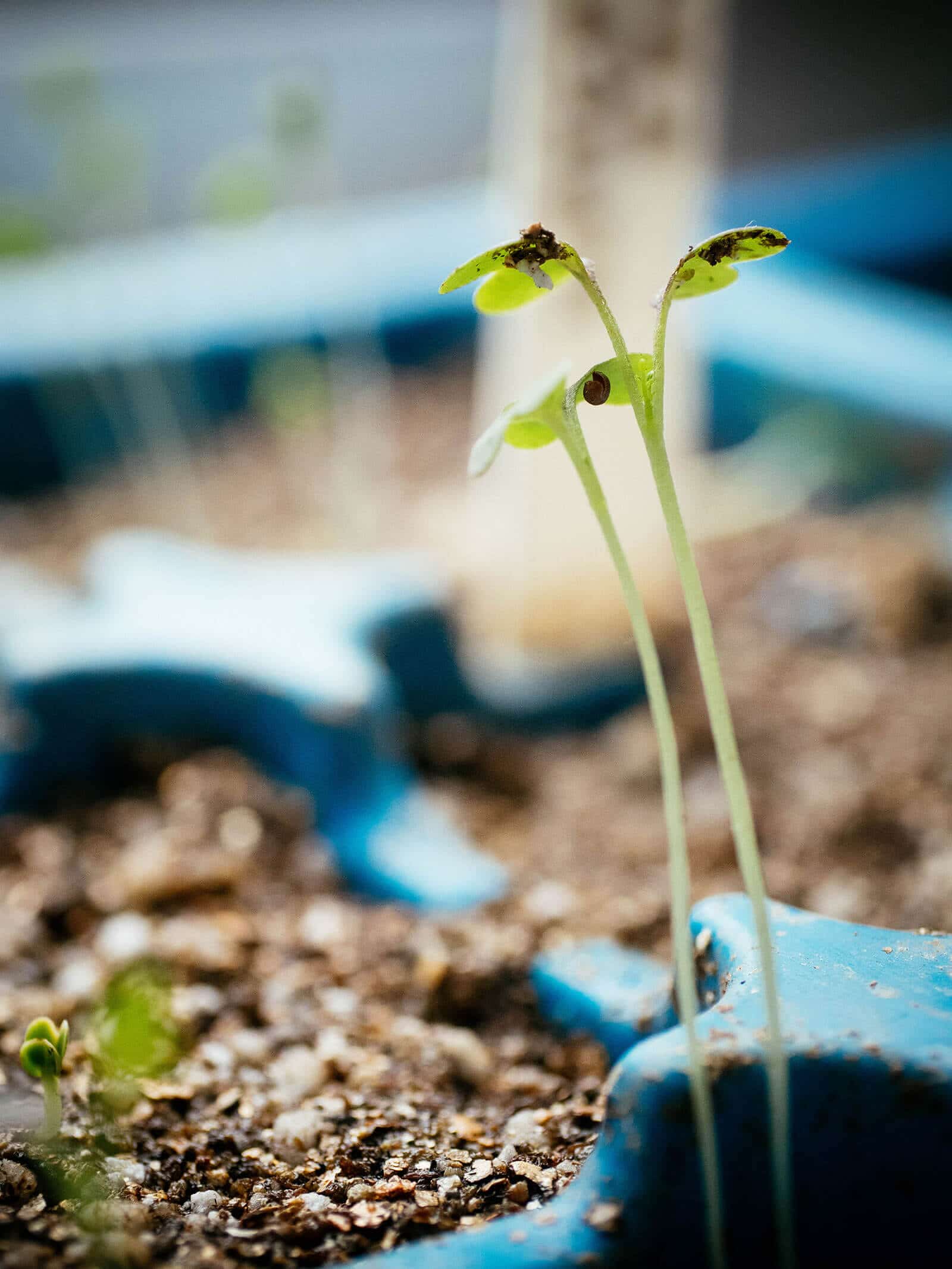
If uncorrected, the condition can weaken their stems, stunt their growth, or make them defenseless against pests and diseases. They’re a little more challenging to harden off, and are less likely to withstand wind and rain once they’re in the ground.
The good news is, leggy seedlings can usually be saved before it’s too late. I’ve transplanted hundreds of tall, floppy seedlings with success, most of which went on to recover and have normal, productive yields. And certain types of leggy seedlings (such as tomatoes and tomatillos) can actually benefit from their long, lanky stems if you transplant them correctly.
If you notice your seedlings leaning too much or looking thin and frail, keep reading for seven easy ways to fix them.
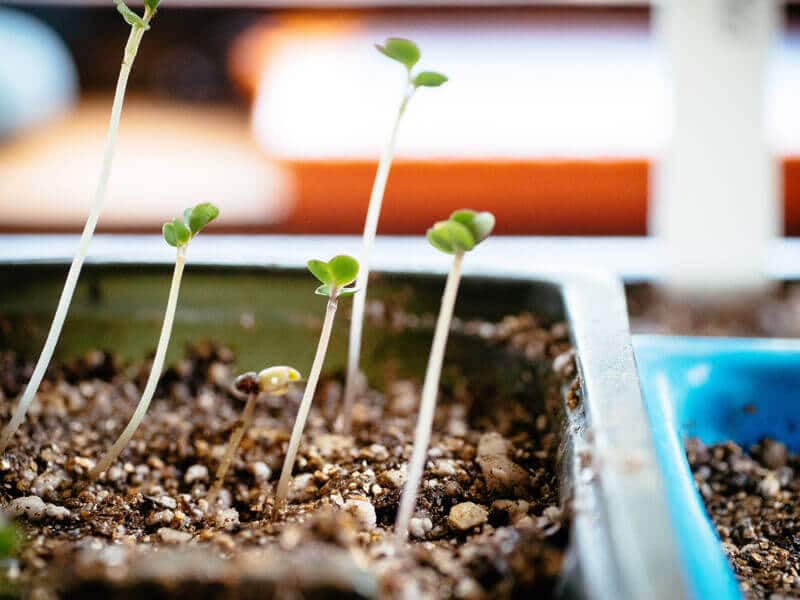
Fix #1: Starting seeds in front of windows? You need more light.
Seedlings have a natural tendency to grow toward light. When the light source is too dim or too far away, the seedlings kick into survival mode and grow quickly in height to try to get closer to that light.
Unfortunately, there’s only so much growing a seedling can do and what it gains in height, it sacrifices in girth, resulting in thin, fragile stems. This is why, with seeds started on window sills, you might notice your seedlings leaning toward the sun, sometimes to the point of bending completely sideways.
It’s a double whammy for seedlings that do this because being bogged down in the seed starting mix—where it’s moist and warm—can also make them more susceptible to damping off disease.

For the majority of home gardeners, the number-one cause of leggy seedlings is almost always insufficient light—so the easiest fix is to give them more light ASAP!
Even if you place them in a south-facing window, the average amount of sunlight in late winter to early spring (when indoor seed starting usually happens) is much less than the 12 to 16 hours needed for strong seedling development. Factor in newer windows with UV-blocking or reflective coatings, and even less light is transmitted.
Most vegetable seedlings are long-day plants that thrive with 16 hours of light (and 8 hours of dark). An artificial light is the easiest way to achieve this, especially for northern gardeners with short growing seasons.
Here’s an easy grow light setup
My current recommendation is to go with integrated LED grow lights (over fluorescent shop lights) for their energy efficiency, longevity, convenience, and cost.
There are tons of options for grow lights, but in this case, we specifically need lights for seedlings and starts—that is, vegetative growth only.
In this leafy stage, plants use more blue and blue-green light (versus later on in their life cycles when they use more red light for flower and seed production). So for seed starting, lights that are labeled as “blue-green spectrum” or “balanced light spectrum” will work best.
Disclosure: If you shop from my article or make a purchase through one of my links, I may receive commissions on some of the products I recommend.
What to buy
If you’re on a budget
You can pick up a set of LED shop lights (5000K to 6500K, with at least 2,000 to 3,000 lumens—the more, the better) and hang them a few inches above your seed starting trays. Plug them into a programmable timer that turns the lights on for 14 to 16 hours a day, and you’re in business.
What to buy
If you want a full-spectrum grow light
If you want a more versatile light for all stages of plant growth and for overwintering plants, full-spectrum grow lights are the way to go. The ones I linked above have built-in reflectors and will provide your plants with all the light they’ll need for germination, growth, and bloom.
If you’re already using fluorescent shop lights and can’t figure out why your seedlings are still leggy (especially compared to past years)…
Think back to when you first got those lights. Fluorescent bulbs do become dimmer over time, even if our eyes can’t perceive the change. A simple replacement may be all you need to prevent leggy seedlings—I recommend either T5 tube lights or T8 tube lights.
Fix #2: Be aware of the ambient room temperature and adjust as needed.
Overly high temperatures, such as those maintained over a heating mat or under a humidity (germination) dome, can lead to a rapid growth spurt in seedlings.
As soon as the seeds germinate, they respond to the heat by putting up tall, skinny stems before leaf production has a chance to catch up. This results in unbalanced seedlings that are “all legs.”
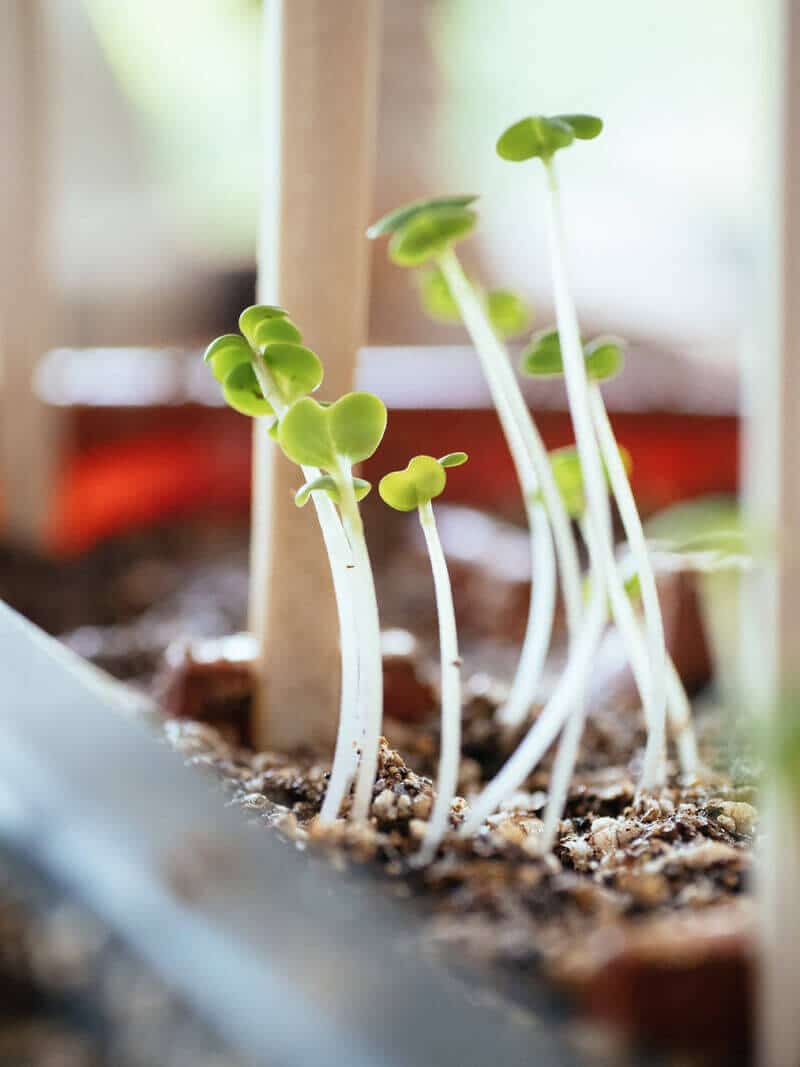
While warmer temperatures between 75°F and 80°F are ideal for germination, most seedlings grow best at a high of 65°F to 70°F during the day and a low of 55°F to 60°F at night.
Be sure to remove the humidity domes from your seedling trays or take them off the heating mats within a couple days of sprouting. Seedlings left to grow in such environments develop thread-thin stems that are far too fragile to survive in overly humid or hot conditions.
Fix #3: Water from the bottom up to provide consistent moisture.
If you’re inconsistent with watering and the seed starting mix often dries out between watering days, it prevents the seedling from growing a strong stem and leafing out well. Continued lack of moisture will turn them spindly and eventually kill them as they’re unable to access the nutrients they need from the soil.
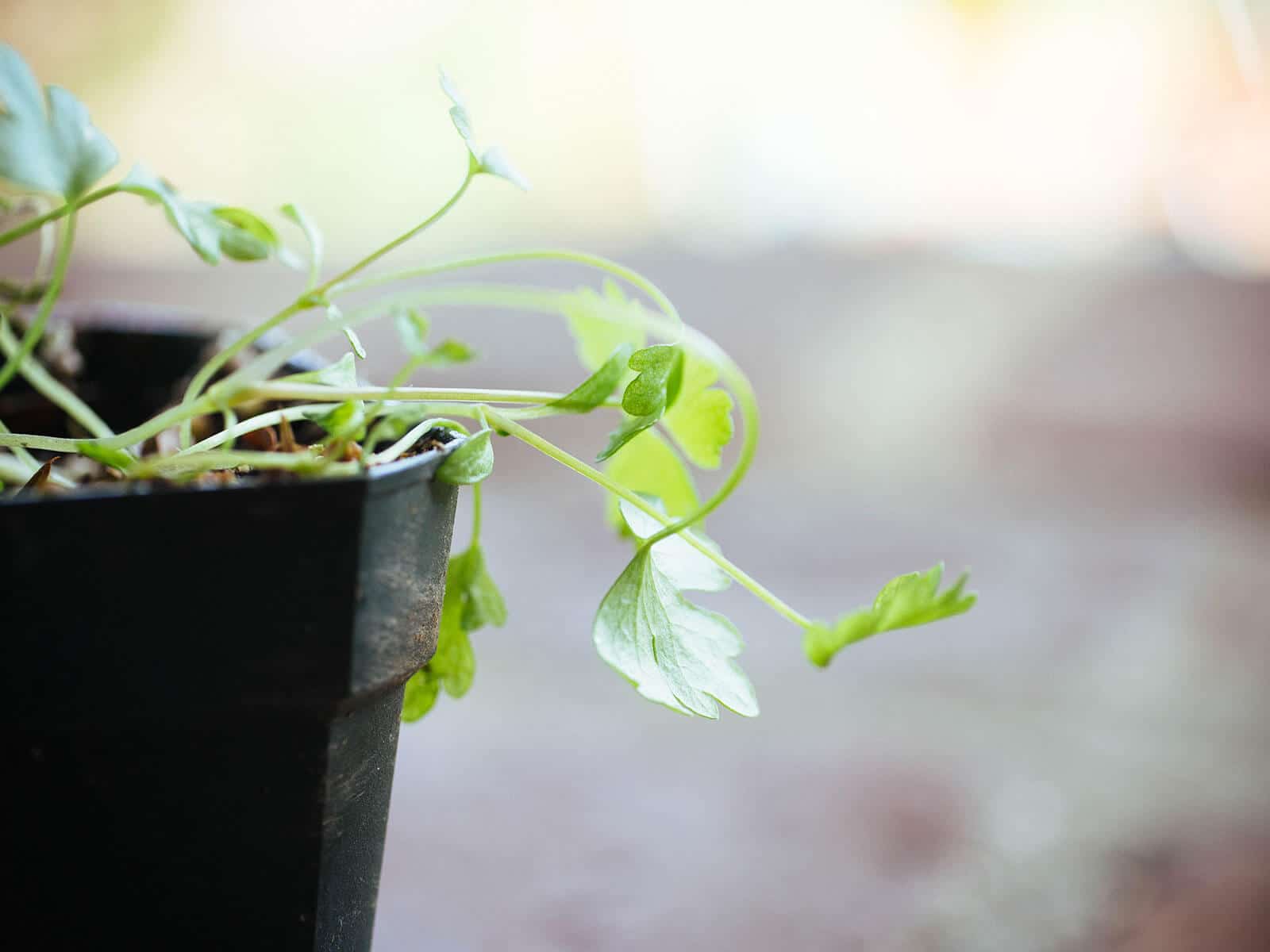
Even if you’re religiously spritzing your seedlings with a spray bottle, there’s no guarantee the water is making it all the way down to the bottom (especially if you sow seeds in deeper containers).
Bottom watering ensures the entire seed starting medium is moist and encourages roots to spread downward.
To fully hydrate your seedlings, place your seedling pots in a tray, fill the tray with water, and let the pots “wick up” as much moisture as they need.
Fix #4: Give proper spacing between seedlings.
With tiny seeds, it’s tempting to simply scatter them in one large tray and thin the seedlings as they grow, but proper spacing helps prevents leggy seedlings as well.
Read more: How to plant intensively in a raised bed to maximize your harvest
If you don’t manage them during initial development, overcrowded seedlings will try to grow taller and taller as they compete with each other for light.

To promote good plant health and keep seedlings from stretching for light, space them no less than an inch or two apart once they develop the first true leaves. Overcrowded seedlings will compete for light, and lack of proper airflow also makes them more vulnerable to pests and diseases.
Fix #5: Build stronger stems on your seedlings by brushing them.
Leggy seedlings can sometimes be strengthened and saved by gently brushing your fingers back and forth along the tops of the plants every day. This simple motion simulates an outdoor breeze and tricks the seedlings into thinking they need to grow thicker stems to hold up against windy conditions.
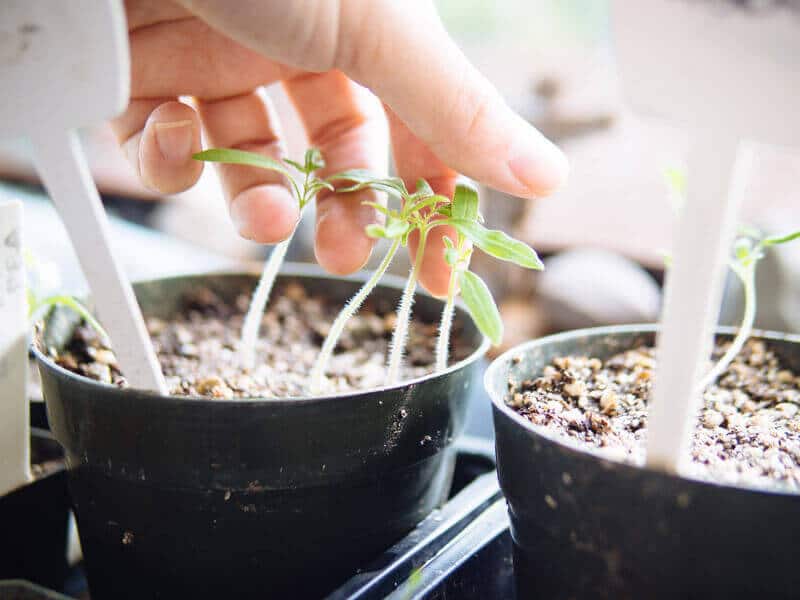
You can also circulate a small oscillating fan near your seedlings (for a few hours a day) for the same purpose (and it does double duty by reducing the chances of damping off).
Just be sure to keep an eye on your seedlings if you have a fan running, as they may be prone to drying out more quickly.
Fix #6: Transplant seedlings outside as soon as conditions are ideal.
If the soil is warm enough and the seedlings are mature enough to be transplanted, harden them off and get them outside in the sun to keep them from growing leggier.
Sometimes, seedlings live indoors longer than they should because of bad timing with frost or slow turnover with older plants in the garden. Use a planting calendar that’s customized to your zip code so you can better time your seed starting and transplanting.
If you jumped the gun on your seed starting this year or got some unexpected weather, there’s still hope: Rather than leaving your seedlings in their trays or tiny pots to continue growing, repot them individually into larger containers and move them to a space indoors that gets plenty of sunlight or artificial light.
Fix #7: Got leggy tomato seedlings? Here’s a bonus tip to boost root development.
If you have leggy tomato seedlings, the best way to correct them is to repot the seedlings (or transplant them) and bury the stems up to the lowest set of leaves.
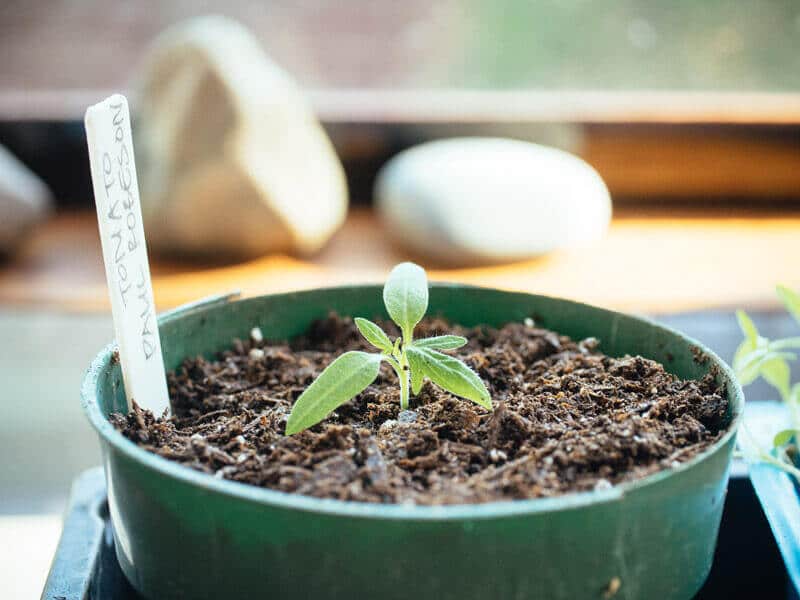
Not only will this fix any problems with legginess, it’s a recommended practice to strengthen tomato stems and help their roots form more mass.
This is because a tomato stem has the ability to grow adventitious roots: tiny root-like nubs that sometimes seem to grow in the air. These adventitious roots (also called root initials or tomato stem primordial) are the earliest stage of development of the plant’s roots. If any part of the stem comes in contact with soil, the adventitious roots can develop into full-blown roots, anchoring the stem and further strengthening the plant’s overall root system.
I personally like to up-pot tomato seedlings at least twice before I transplant them in the garden. Don’t worry about digging a super deep hole at this point, as you can simply plant your tomato in a shallow trench and save your back!
By the way, this method of partially burying stems also works for tomatillo, eggplant, and pepper seedlings (whether they’re leggy or not).
This post updated from an article that originally appeared on February 21, 2017.


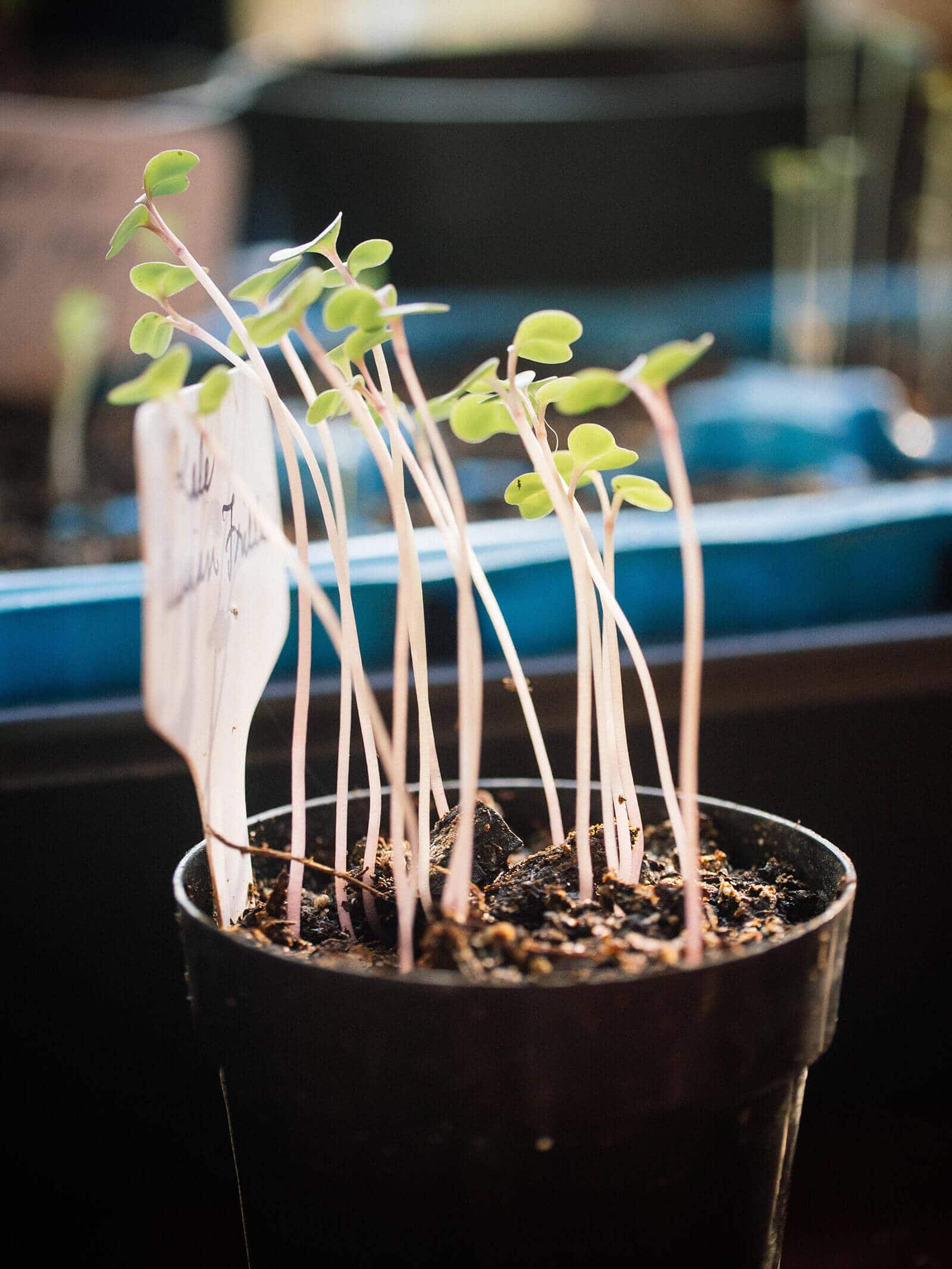













Hello, Linda.
I currently have a bad case of leggy tomato seedlings. Do I need to wait until their second sets of leaves develop before I repot them, or should I do it ASAP? The seedlings are about 3 inches-ish tall and have been planted for about 3 – 3.5 weeks now, if that helps.
If seed starting indoors start by only filling the cups 1/2 way with seed starting mix. Once your seedlings are about an inch and a half tall, carefully fill in about an inch of dry garden soil over the seed starting medium. Don’t use wet medium as it is too easy to crush the plant. Then moisten it afterwards. This will cause them to grow more roots. Most vegetables in the Solanaceae that includes cucumbers and nightshades like tomatoes will grow roots on any part of the stem that is in contact with moist soil. Just like when you transplant you bury 3/4 of the stem up to the first set of leaves. More roots means they can make and store more glucose and that energy will help thicken the stem. I don’t recommend watering from the bottom until you get to the thick stem. You want the roots to branch out to get a good anchor not just send a few main roots down. Once they are sprouting a second set of leaves then you can start watering from the bottom. Also rotate your plants so the sun is coming from a different direction each day. They will naturally change their lean toward the light and that will stimulate stem strengthening as well.
Do you know if this applies to cannabis seeds as well?
I have leggy luffa seedlings – the light is good, water is good. I’m wondering if I should re-pot and bury part of that leggy stem?
I’m not aware of luffa being able to develop adventitious roots, but as it’s a vining plant, it’s supposed to grow long and climb a trellis.
I wonder if dill is particularly vulnerable to this, as all my other seedlings seem either completely fine or at least mostly fine*, except for the dill which turned out to grow VERY leggy. Not sure what to do with it now.
I think it might be the temperature.
*Not entirely sure if my lemon basil should grow this way, but every picture of it I saw seemed to have very long, thin stems and it’s very…I guess sturdy? It’s starting to grow bark.
Dill tends to grow very tall, but as it grows, it should be pinched back to keep it from getting leggy. Same for basil — if you pinch the basil back periodically, it’ll keep it nice and bushy.
Another group that can be saved by planting them up to their chins is cabbage, pak choy and broccoli. We accidentally grew them at too high a temp this year and almost lost all 100 of our plants. I did some research and found that it might be possible to save them. The article was very clear about the chances though because the stems would be so fragile that the soil might crush them. I decided to give it a shot and use my super light seedling starter soil. Every plant survived and are hardened enough now to plant! Even if you can’t save all the plants, it’s worth a shot.
Interesting, I’ve never read anything on that. Do those brassicas grow roots from their stems? And would that same method apply to related plants like kale, brussels sprouts, etc.?
I’m so sorry it took me so long to reply! No, brassicas don’t grow roots from the stems but supporting the stems with the ultra light soil buys enough time for the roots to develop and the stems to thicken enough to create a healthy plant. We had a decent harvest but I think the plants were a bit stunted compared to this year. I was a lot more careful about temperature when growing the seedlings and got them hardened earlier. They look a lot more robust with excellent biofilm this year.
I don’t know if lettuce and kale grow roots from their stems but always plant them deeply up to the first leaves.
As with tomatoes, can I bury my leggy dill seedlings up to the lowest set of leaves too?
I’m not certain dill has the ability to grow roots along its stem, so I don’t believe you can bury a leggy dill stem the way you do for tomatoes.
If I can’t save them do I just throw them in the trash? That seems so wasteful. Can they be composted or broken up and mixed with some type of soil for be reused? I’m very new to gardening so I don’t know all the terminology.
You can eat them, if they haven’t died. They’re basically just sprouts. Or yes, you can compost them. Leggy seedlings aren’t diseased, they’re just lanky and less certain to grow into strong plants.
As an ultra-budget friendly suggestion from the UK – add a high tinfoil collar to your windowsill seed trays. The foil reflects light back onto your seedlings as the sun travels across the window. It’s not quite as good as lights, but it’s usually enough to prevent legginess and keep the seedlings growing & happy till the days are warm enough to put them outside.
I should caution that if the foil has any crinkles, it won’t reflect evenly and could cause hotspots. A flat sheet of white paper (or white board) would work better in this case.